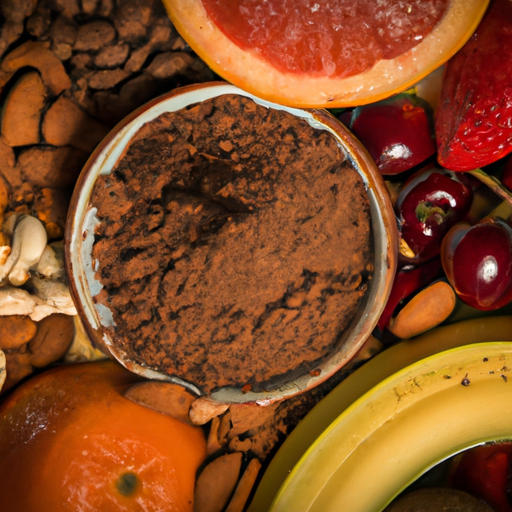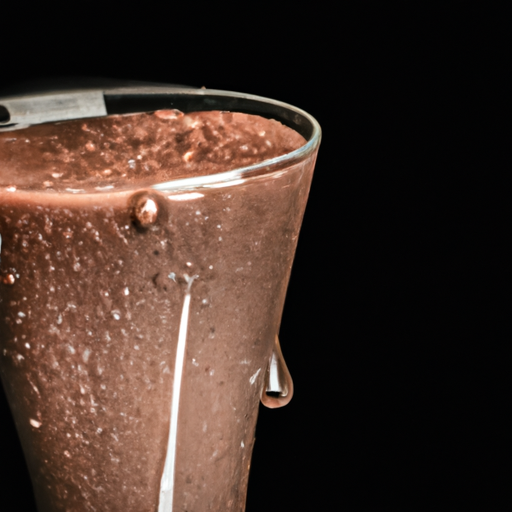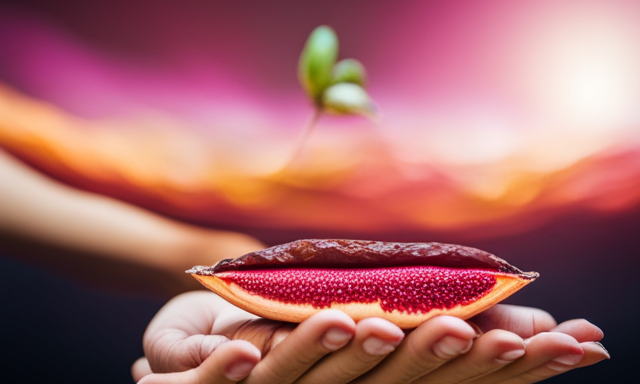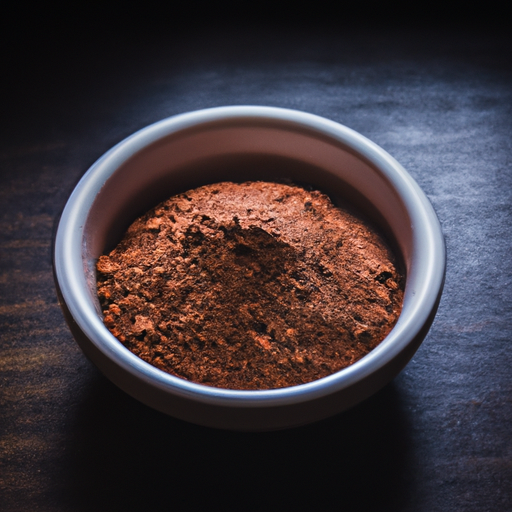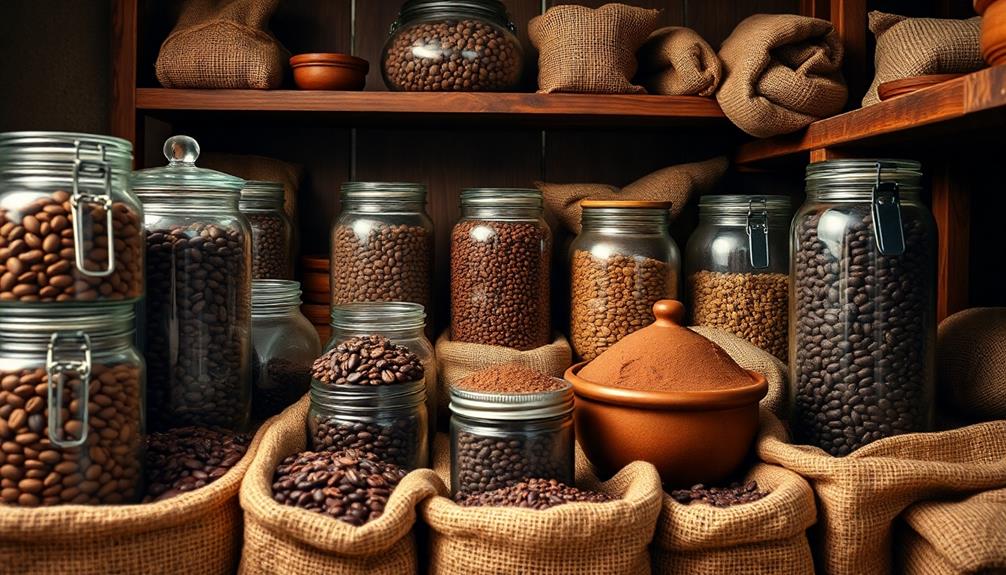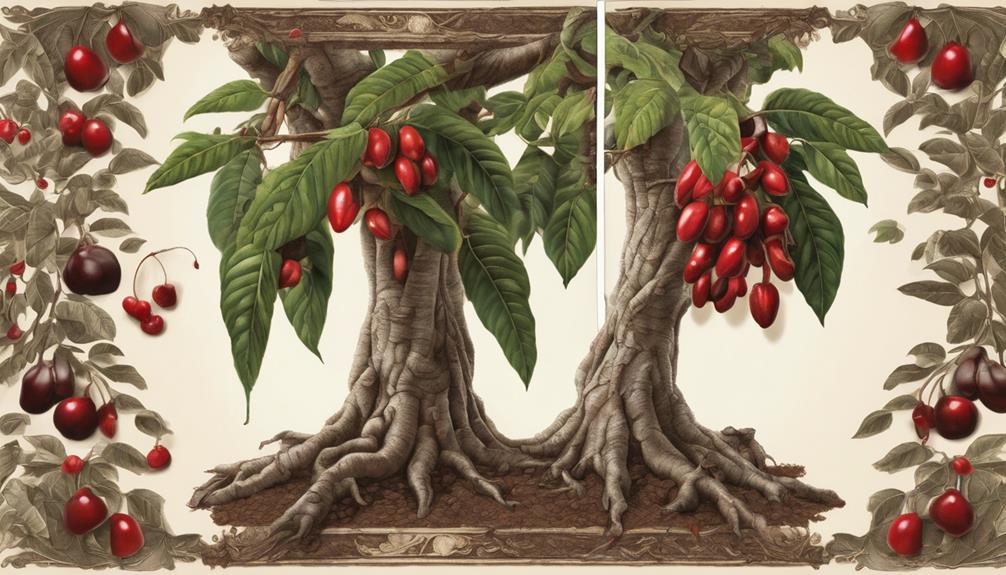While enjoying a warm cup of hot cocoa, I ponder the nutritional advantages of this delicious treat. Raw cacao powder, the primary component in my indulgence, is renowned for its health benefits. I find myself questioning the amount of fiber present in raw cacao powder.
Fiber, the unsung hero of a balanced diet, plays a crucial role in our overall well-being. It aids in digestion, keeps us feeling full, and supports a healthy gut. Incorporating fiber-rich foods into our daily routine is essential, and raw cacao powder might just be the surprising addition we’ve been missing.
In this article, we’ll explore the nutritional composition of raw cacao powder and delve into the importance of fiber in a balanced diet. We’ll uncover just how much fiber is locked within this heavenly ingredient, and discover creative ways to incorporate it into our daily routine. So join me on this fiber-packed journey as we explore the goodness of raw cacao powder.
Key Takeaways
- Cacao percentage affects fiber content
- Avoid cacao with added sugars or fillers
- Ways to incorporate raw cacao powder: smoothies, oatmeal, energy balls
- Use raw cacao powder as a replacement for cocoa powder in baking
What is Raw Cacao Powder?
If you’re looking to satisfy your chocolate cravings while still getting a healthy dose of antioxidants and minerals, raw cacao powder is your go-to ingredient.
This superfood is derived from the cacao bean, which is the base ingredient used to make chocolate. Unlike processed cocoa powder, raw cacao powder is made by cold-pressing unroasted cacao beans, preserving its natural nutrients.
Consuming raw cacao powder has numerous benefits, including improved heart health, enhanced brain function, and reduced inflammation. Additionally, it contains various minerals such as magnesium, iron, and potassium.
There are different types of raw cacao powder available, including organic and non-organic varieties. These options allow you to choose the one that aligns with your personal preferences and dietary needs.
Now let’s explore the nutritional composition of raw cacao powder.
The Nutritional Composition of Raw Cacao Powder
Indulging in this rich superfood will surely leave you pleasantly surprised by its nutritional content. Raw cacao powder is packed with essential nutrients that can boost your overall health.
In terms of its nutritional value, raw cacao powder is a great source of fiber. Just one tablespoon of raw cacao powder contains about 2 grams of fiber, which is around 8% of the daily recommended intake.
Fiber is known for its numerous health benefits, including promoting healthy digestion, regulating blood sugar levels, and reducing the risk of heart disease. It also helps in maintaining a healthy weight and preventing constipation.
So, incorporating raw cacao powder into your diet can not only satisfy your sweet tooth but also provide you with a good amount of fiber. This makes it a great addition to a balanced diet focused on overall well-being.
Health Benefits of Fiber
Incorporating fiber into your diet is like adding the foundation to a sturdy house, providing the necessary support for healthy digestion, regulated blood sugar levels, and reduced risk of heart disease. Here are four reasons why fiber is essential for your overall health:
-
Fiber and digestion: Fiber acts as a broom, sweeping through your digestive system and keeping things moving smoothly. It adds bulk to your stool, preventing constipation and promoting regular bowel movements.
-
Fiber and weight loss: High-fiber foods help you feel fuller for longer, reducing the likelihood of overeating. It also slows down the absorption of sugar into your bloodstream, preventing spikes in blood sugar levels that can lead to cravings and weight gain.
-
Fiber and heart health: Soluble fiber, found in foods like oats and beans, can help lower cholesterol levels and reduce the risk of heart disease.
-
Fiber and balanced diet: Including fiber-rich foods, such as fruits, vegetables, whole grains, and legumes, is crucial for maintaining a balanced and nutritious diet.
Transitioning into the next section about the importance of fiber in a balanced diet, it is clear that fiber plays a vital role in supporting overall health and wellbeing.
Importance of Fiber in a Balanced Diet
Including fiber-rich foods in your diet is essential for maintaining a balanced and nutritious eating plan that supports your overall health and wellbeing.
Fiber plays a crucial role in digestion, as it adds bulk to your stool and promotes regular bowel movements, preventing constipation.
Additionally, fiber helps regulate blood sugar levels by slowing down the absorption of sugar into the bloodstream, which can be beneficial for individuals with diabetes or those looking to manage their weight.
By increasing feelings of fullness and reducing appetite, fiber can aid in weight management.
It also helps control cholesterol levels and lowers the risk of heart disease.
Now, let’s dive into the specific amount of fiber found in raw cacao powder.
How Much Fiber is in Raw Cacao Powder?
Raw cacao powder is a fantastic source of dietary fiber, providing a significant boost to your daily fiber intake. Fiber is an essential nutrient that plays a crucial role in maintaining a healthy digestive system and promoting overall well-being. Incorporating fiber-rich foods into your diet, such as raw cacao powder, can have numerous benefits for your health. So, how much fiber is in raw cacao powder?
To answer that question, let’s take a look at the table below:
| Serving Size (1 tbsp) | Fiber Content |
|---|---|
| Raw Cacao Powder | 2 grams |
As you can see, just one tablespoon of raw cacao powder contains 2 grams of fiber. This makes it an excellent addition to your diet if you’re looking to increase your fiber intake.
Now that we know how fiber-rich raw cacao powder is, let’s explore ways to incorporate it into your diet without missing out on its benefits.
Ways to Incorporate Raw Cacao Powder into Your Diet
One delicious way to enjoy the benefits of raw cacao powder is by adding it to your morning smoothie, like a burst of chocolatey goodness. Not only does it add a rich, decadent flavor, but raw cacao powder is also packed with fiber and other nutrients.
To incorporate raw cacao powder in smoothies, simply blend it with your favorite fruits, vegetables, and a liquid of your choice. You can also try adding a tablespoon of raw cacao powder to your favorite smoothie recipe for an extra dose of fiber.
Additionally, raw cacao powder can be used in various recipes, such as energy balls, homemade granola bars, or even in baking. It’s a versatile ingredient that can be easily incorporated into your diet for added fiber and chocolatey goodness.
Speaking of fiber, there are other sources to include in your diet that can complement the benefits of raw cacao powder.
Other Sources of Fiber to Include in Your Diet
Now that we know how to incorporate raw cacao powder into our diet, let’s explore other sources of fiber that we can include to further enhance our nutritional intake.
High fiber fruits, such as raspberries, apples, and pears, are excellent choices to increase our fiber intake. These fruits not only provide a sweet and refreshing taste but also contain essential vitamins and minerals.
Additionally, incorporating whole grain foods like oats, brown rice, and quinoa into our meals can significantly boost our fiber consumption. These whole grains are rich in fiber and promote a healthy digestive system.
By diversifying our sources of fiber, we can ensure that we are getting a well-rounded nutritional profile.
Now, let’s move on to some tips for choosing and using raw cacao powder in our everyday cooking and baking.
Tips for Choosing and Using Raw Cacao Powder
Looking to add a burst of rich chocolate flavor to your recipes? Let’s dive into some helpful tips for selecting and utilizing the versatile raw cacao powder in your everyday cooking and baking adventures. When choosing a cacao brand, opt for organic and fair-trade options to ensure the highest quality and support sustainable practices. Look for brands that specify the cacao percentage and avoid those with added sugars or fillers. To get the most fiber from raw cacao powder, incorporate it into recipes like smoothies, oatmeal, or energy balls. You can also use it as a replacement for cocoa powder in baking. Experiment with different recipes to find your favorite way to enjoy the fiber-packed goodness of raw cacao powder. In the next section, we’ll explore the benefits and conclude with how to incorporate it into your diet seamlessly.
Conclusion: Enjoy the Fiber-Packed Goodness of Raw Cacao Powder
Indulge in the delectable richness of raw cacao powder and savor the incredible fiber-packed benefits it brings to your recipes. Adding raw cacao powder to your dishes not only enhances their flavor but also boosts their fiber content. Here are three ways you can enjoy the fiber-rich goodness of raw cacao powder:
-
Smoothies: Blend raw cacao powder with fruits, vegetables, and a source of fiber, such as chia seeds or oats, to create a delicious and filling smoothie packed with fiber.
-
Baked Goods: Incorporate raw cacao powder into your favorite baked goods, like muffins or brownies, by replacing a portion of the flour with cacao powder. This adds a rich chocolate flavor and boosts the fiber content.
-
Energy Balls: Mix raw cacao powder with dates, nuts, and seeds to create nutritious and fiber-rich energy balls. They make for a great on-the-go snack that satisfies your sweet tooth while providing essential fiber and nutrients.
Enjoy these fiber-rich recipes and reap the benefits of high fiber foods in a delicious and enjoyable way.
Frequently Asked Questions
Can raw cacao powder be used as a substitute for cocoa powder in recipes?
Yes, raw cacao powder can be used as a substitute for cocoa powder in recipes. While they come from the same source, raw cacao powder is less processed, retaining more nutrients and antioxidants, making it a healthier option.
Are there any potential side effects of consuming too much fiber from raw cacao powder?
Consuming too much fiber from raw cacao powder can lead to potential health risks. It’s important to be aware of your recommended daily fiber intake and not exceed it, as excessive fiber intake can cause digestive issues.
Is raw cacao powder suitable for individuals with dietary restrictions, such as gluten-free or vegan diets?
Raw cacao powder is suitable for individuals with dietary restrictions such as gluten-free or vegan diets. It is naturally gluten-free and can be used in a variety of vegan recipes to provide numerous health benefits.
Can raw cacao powder help with weight loss due to its fiber content?
Raw cacao powder can aid in weight loss by promoting feelings of fullness and improving digestion. While the exact amount of fiber may vary, its high fiber content contributes to satiety and supports a healthy weight.
Are there any specific storage requirements for raw cacao powder to maintain its nutritional value and fiber content?
To maintain the nutritional value and fiber content of raw cacao powder, it is important to store it in a cool, dry place away from direct sunlight. This helps preserve its antioxidants, minerals, and dietary fiber, ensuring maximum benefits.
Does Raw Cacao Powder Have Both High Fiber and Caloric Content?
Raw cacao powder is indeed a nutritional powerhouse with a wonderful balance of high fiber and caloric content. With around 12 grams of fiber per ounce, it supports a healthy digestive system, while the moderate calories in raw cacao powder, about 120 per ounce, provide a satisfying treat.
Conclusion
As I conclude my exploration of the fiber-packed goodness of raw cacao powder, I am reminded of the power it holds.
Like a rich tapestry, raw cacao powder weaves together health benefits and nutritional value.
Its fiber content acts as a strong thread, binding our digestive system and promoting optimal health.
Just as a tapestry brings beauty to a room, incorporating raw cacao powder into our diet brings beauty to our well-being.
So let us embrace this nutrient-rich gift and savor the benefits it brings.

